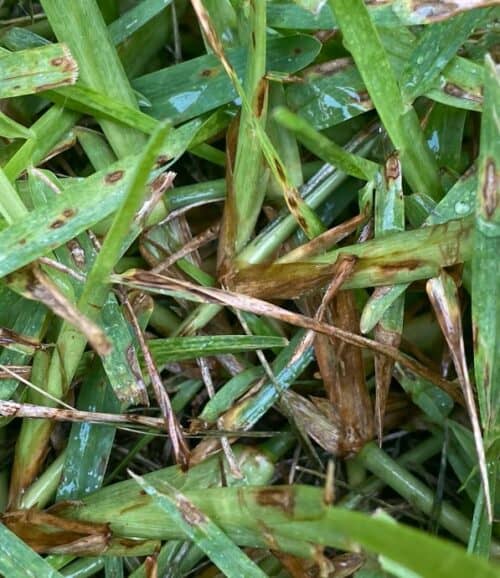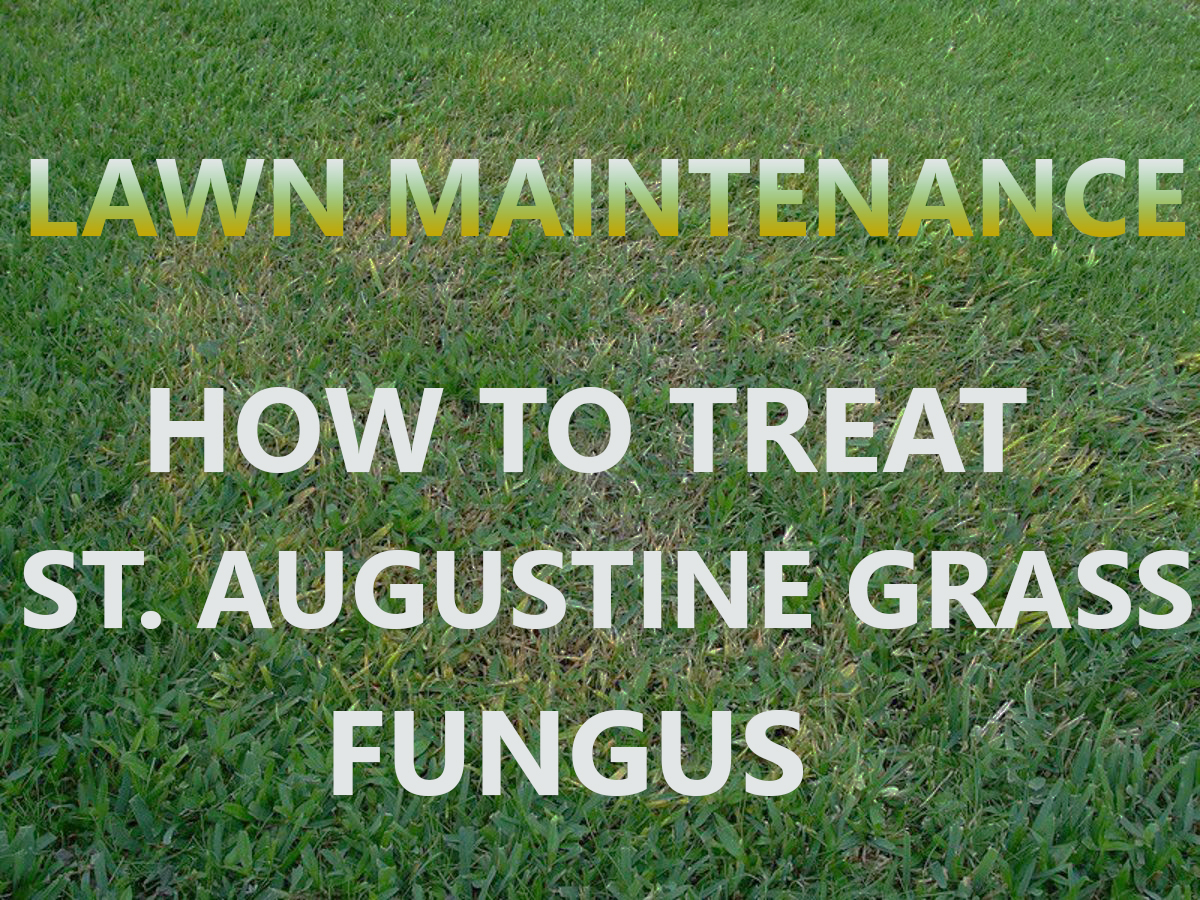To treat fungus in St Augustine grass, you can use fungicides specifically formulated for this grass type. These fungicides help eliminate and prevent further growth of fungus in the grass.
Having a lush and healthy St Augustine grass lawn requires regular maintenance and care. However, fungal diseases can pose a significant threat to the health and appearance of your grass. Identifying and treating these fungal infections promptly is crucial to ensuring the vitality of your lawn.
We will discuss how to effectively treat fungus in St Augustine grass using fungicides. By following the recommended steps and using the appropriate products, you can restore your lawn to its vibrant and healthy state. So, let’s dive into the details of treating fungus in St Augustine grass.

Credit: weedexlawn.com
Identifying Fungus In St Augustine Grass
Fungus is a common issue that can affect St Augustine grass. Identifying the presence of fungus in your lawn is crucial for effective treatment. Visual cues are a helpful way to detect fungus in St Augustine grass. Look for signs such as discolored patches, yellowing or browning of the grass blades, and the presence of white or black threads.
Fungus can also cause the grass to feel mushy or slimy. If you notice these signs, it’s important to take action promptly to prevent further damage. Applying fungicides, adjusting watering habits, and improving air circulation are some ways to treat fungus in St Augustine grass.
Regular observation and preventive measures can help keep your lawn healthy and fungus-free.
Common Types Of Fungus Affecting St Augustine Grass
St Augustine grass is susceptible to several types of fungus, including Brown Patch Fungus, Take-All Root Rot, and Gray Leaf Spot. These fungal infections can cause significant damage to the grass if left untreated. Brown Patch Fungus typically appears as circular brown patches on the lawn, while Take-All Root Rot affects the grass’s roots, leading to thinning and discoloration.
Gray Leaf Spot manifests as gray or brown spots on the blades of grass. To effectively treat fungus in St Augustine grass, it is crucial to identify the specific type of fungus present and apply the appropriate fungicide. Proper lawn maintenance practices such as regular mowing, proper watering, and adequate fertilization can also help prevent and manage fungal infections.
Regularly inspecting the lawn and promptly addressing any signs of fungal growth is essential for maintaining a healthy and beautiful St Augustine grass lawn.
How to Treat Fungus in St Augustine Grass: Step by Step Guide
Treating Fungus In St Augustine Grass
Treating fungus in St Augustine grass involves implementing cultural practices for prevention. These practices include proper watering techniques and regular mowing to maintain optimal grass health. Selecting the right fungicide is crucial in treating the fungus effectively. It is important to choose a fungicide that specifically targets the type of fungus affecting the St Augustine grass.
Once the fungicide is selected, it should be applied effectively. This involves following the instructions on the product label and evenly distributing the fungicide across the affected areas. Timing and frequency of treatments are also important factors to consider. Fungicides should be applied according to the recommended schedule to ensure maximum effectiveness.
Regular monitoring of the grass is necessary to identify any recurrent signs of fungus and prompt treatment. With the right cultural practices and proper use of fungicides, St Augustine grass can be effectively treated for fungus.
Natural Remedies For Fungal Infections In St Augustine Grass
Fungal infections in St Augustine grass can be effectively treated using natural remedies. Organic approaches are highly recommended to control the spread of fungus in your lawn. Homemade remedies can be prepared at home using ingredients readily available. These remedies not only treat the infection but also enhance the overall health of your grass.
By opting for natural treatments, you can avoid the use of harsh chemicals that may harm the environment. Some common remedies include using neem oil, baking soda, or compost tea. Regularly mowing the grass at the appropriate height and maintaining proper irrigation can also help prevent fungal infections.
Taking a proactive approach to lawn care and using organic methods can ensure your St Augustine grass remains healthy and vibrant.
Consulting Experts For Fungal Infections In St Augustine Grass
Fungal infections in St Augustine grass should be treated by consulting experts who can provide proper advice. Seeking professional advice is important in order to effectively address the issue. Hiring a lawn care specialist would be a wise choice as they have the necessary experience and knowledge in dealing with fungus in grass.
Additionally, collaborating with an arborist or agronomist can provide further insight and expertise in the treatment process. These professionals can assess the severity of the fungal infection and recommend the best course of action. By relying on their expertise, homeowners can ensure that their St Augustine grass is effectively treated and restored to its healthy state.
Preventive Measures To Avoid Fungal Infections In St Augustine Grass
Fungal infections in St Augustine grass can be prevented by following proper watering techniques. It is important to water the grass deeply but infrequently, allowing the soil to dry out between waterings. This helps to discourage the growth of fungi.
Additionally, maintaining suitable levels of nitrogen and phosphorus in the soil is crucial. Too much nitrogen can make the grass susceptible to infections, while a deficiency in phosphorus can weaken the grass and make it more vulnerable to fungi. Regular maintenance and monitoring of the grass can also help in early detection of any signs of fungal infections.
Keeping the grass well-mowed and removing any thatch buildup can reduce the risk of fungal growth. By implementing these preventive measures, you can ensure the health and longevity of your St Augustine grass.
Frequently Asked Questions For How To Treat Fungus In St Augustine Grass
What Kills Fungus On St Augustine Grass?
To kill fungus on St. Augustine grass, use fungicides that are specifically designed for lawn care.
Will St Augustine Recover From Fungus?
St. Augustine grass can recover from fungus with proper treatment and care.
How Do You Treat St Augustine Fungus Naturally?
Treat St. Augustine fungus naturally with proper lawn maintenance, including regular watering, mowing, and aerating.
Why Does St Augustine Grass Get Fungus?
Fungus affects St Augustine grass due to excess moisture, poor air circulation, and improper lawn care.
Conclusion
To effectively treat fungus in St. Augustine grass, it’s essential to take prompt action and follow the proper steps. By identifying the type of fungus and applying the appropriate fungicide, you can prevent further damage and promote the health of your lawn.
Regular maintenance practices such as proper watering, mowing, and fertilizing can also play a crucial role in preventing fungal growth and maintaining a vibrant, fungus-free lawn. Remember to remove any diseased plant material and properly dispose of it to prevent the spread of the fungus.
Additionally, maintaining good soil health and ensuring proper drainage can reduce the risk of fungal infections. With consistent care and attention, you can keep your St. Augustine grass looking lush, green, and free from fungal problems. Invest in the health of your lawn and enjoy the beauty it brings to your outdoor space.

